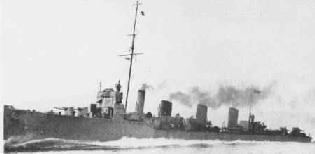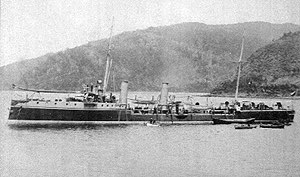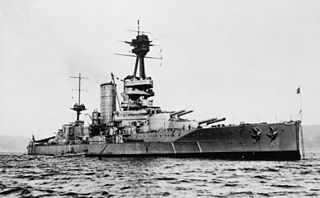
HMS Marlborough is a Duke-class Type 23 frigate formerly in service with the Royal Navy, and the sixth ship to bear the name. She was named after John Churchill, 1st Duke of Marlborough. The ship entered service with the Royal Navy in 1991 and served in the Middle East. The frigate was taken out of service in 2005 and sold to Chile. The vessel entered service with the Chilean Navy in 2008 as Almirante Condell. The ship was significantly upgraded from 2020 to 2021 and remains in service.

The Chilean Navy is the naval warfare service branch of the Chilean Armed Forces. It is under the Ministry of National Defense. Its headquarters are at Edificio Armada de Chile, Valparaiso.

The Chilean frigate Almirante Lynch (PFG-07) is a Condell-class frigate, the third ship of the Chilean Navy to bear the name.

Almirante Lynch was a destroyer in service with the Chilean Navy through World War I and World War II. She was named after Admiral Patricio Lynch, Chilean sailor, hero of the War of the Pacific.

The Serrano class was a series of six destroyers, built to a British design, which served with the Chilean Navy from 1928 to 1967. In 1927 Chile ordered the Serrano class from John I. Thornycroft & Company in the United Kingdom at the cost of £230,000 for each ship to enhance the Chilean Navy's ability to patrol its extensive coastline. The six vessels were completed by 1929. Serrano, Orella and Hyatt were equipped for minelaying, and Aldea, Riquelme and Videla for minesweeping.

In late 19th-century naval terminology, torpedo gunboats were a form of gunboat armed with torpedoes and designed for hunting and destroying smaller torpedo boats. By the end of the 1890s torpedo gunboats were superseded by their more successful contemporaries, the torpedo boat destroyers.

The Faulknor class were a class of flotilla leaders that were under construction in the United Kingdom for the Chilean Navy at the outbreak of World War I. Six ships were ordered by Chile, of which the first two were delivered to Chile before the outbreak of the war. The remaining four ships were purchased by the British, taken over and completed for the Royal Navy for wartime service. In common with Royal Navy convention, they were named after famous Royal Navy captains of the past, in this case the members of the Faulknor family.

The Condell class was the name given to a class of two new build and upgraded type Leander-class frigates of the Chilean Navy, Almirante Condell and Almirante Lynch. They were ordered by the Chilean government in 1969 as ASW frigates. The ships were built between 1969 and 1973, under Chilean modifications, by Yarrow (Shipbuilders) Ltd. in Scotstoun, Glasgow. Almirante Condell arrived in Chile in 1973, with Almirante Lynch following in 1974.

The Almirante class were two destroyers built for the Chilean Navy by Vickers in Barrow in Furness, UK, in 1960, named after Chilean admirals. Their weapons and largely Marconi sensors were in advance of the RN Daring class, but their internal layout resembled that of the Battle class. They served until the late 1990s. They were fitted with a unique Vickers-designed 4-inch dual purpose naval gun, which fired up to 50 rpm. The gun was in advance of the standard RN 4.5-inch guns, more automated and reliable than the Tiger-class 3- and 6-inch mounts, but not water-cooled. It was rejected for RN use because of doubt about its sustained firing, the large stocks of surplus WW2, single 4.5- and twin 4-inch guns which the RN claimed wrongly were close to the new 4-inch N(R) in performance, and mainly because it was a private out-of-house, Vickers design The ships were modernised in Britain in 1975, and decommissioned in the late 1990s.
Several ships of the Chilean Navy have been named Almirante Condell after Admiral Carlos Condell (1846–1912), hero of the Battle of Punta Gruesa during the War of the Pacific:
Several ships of the Chilean Navy have been named Almirante Lynch after Patricio Lynch (1824–1886), a Chilean hero during the War of the Pacific

The Almirante Lynch class were a group of destroyers built for the Chilean Navy prior to World War I. Initially six ships were planned, two being delivered. The other four were purchased by and incorporated into the Royal Navy during World War I as the Faulknor class. Following the war, the three surviving ships were returned to the Chilean Navy and renamed the Almirante Williams class. The class of ships was named after Admiral Patricio Lynch, Chilean sailor, hero of the War of the Pacific.

Chilean frigate Almirante Condell (PFG-06) was a Condell-class frigate of the Chilean Navy, and was the third ship in the Chilean Navy to bear this name.
Almirante Lynch-class destroyer may refer to one of the following ship classes of destroyers of the Chilean Navy:

The torpedo gunboat Almirante Lynch and her sister ship Almirante Condell, were purchased in England and launched in 1890.

The Battle of Caldera Bay, or the Sinking of Blanco Encalada, was a naval engagement fought in the Caldera Bay during the 1891 Chilean Civil War between Balmacedist and Congressional naval forces on 23 April 1891. It involved two Balmacedist torpedo boats of the Almirante Lynch-class, and the Congressional armored frigate Blanco Encalada.

Almirante Latorre, named after Juan José Latorre, was a super-dreadnought battleship built for the Chilean Navy. It was the first of a planned two-ship class that would respond to earlier warship purchases by other South American countries. Construction began at Elswick, Newcastle upon Tyne soon after the ship was ordered in November 1911, and was approaching completion when it was bought by the United Kingdom's Royal Navy for use in the First World War. Commissioned in September 1915, it served in the Grand Fleet as HMS Canada for the duration of the war and saw action during the Battle of Jutland.

The Almirante Latorre class consisted of two super-dreadnought battleships designed by the British company Armstrong Whitworth for the Chilean Navy. They were intended to be Chile's entries to the South American dreadnought race, but both were purchased by the Royal Navy prior to completion for use in the First World War. Only one, Almirante Latorre (HMS Canada), was finished as a battleship; Almirante Cochrane (HMS Eagle), was converted to an aircraft carrier. Under their Chilean names, they honored Admirals (Almirantes) Juan José Latorre and Thomas Cochrane; they took their British names from what was then a dominion of Canada and a traditional ship name in the Royal Navy.

A torpedo cruiser is a type of warship that is armed primarily with torpedoes. The major navies began building torpedo cruisers shortly after the invention of the locomotive Whitehead torpedo in the 1860s. The development of the torpedo gave rise to the Jeune École doctrine, which held that small warships armed with torpedoes could effectively and cheaply defeat much larger battleships. Torpedo cruisers fell out of favor in most of the great power navies in the 1890s, though many other navies continued to acquire them into the early 1900s.

The Almirante Lynch class was a pair of two torpedo gunboats, Almirante Lynch and Almirante Condell, ordered for the Chilean Navy in the late 1880s.















